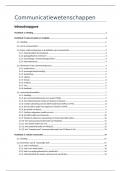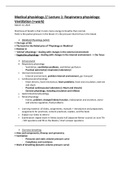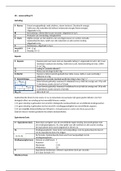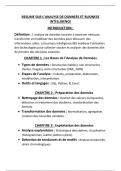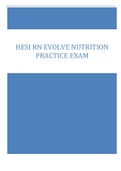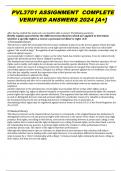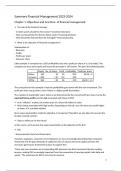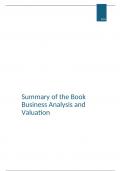Communicatiewetenschappen
Inhoudsopgave
Hoofdstuk 1: inleiding.................................................................................................................................... 1
Hoofdstuk 2: basisconcepten en modellen..................................................................................................... 2
2.1: inleiding.........................................................................................................................................................2
2.2: wat is communicatie?....................................................................................................................................2
2.3: breek- of discussiepunten in de definities van communicatie.......................................................................3
2.3.1: intentionaliteit als breekpunt.................................................................................................................3
2.3.2: geslaagdheid als criterium?....................................................................................................................3
2.3.3: eenrichtings- of tweerichtingsverkeer...................................................................................................3
2.3.4: obervatieniveau......................................................................................................................................4
2.4: elementen in het communicatieproces.........................................................................................................4
2.4.1: zender/bron............................................................................................................................................4
2.4.2: ontvanger/bestemmeling.......................................................................................................................4
2.4.3: boodschap..............................................................................................................................................4
2.4.4: signaal.....................................................................................................................................................5
2.4.5: kanaal.....................................................................................................................................................5
2.4.6: medium...................................................................................................................................................5
2.4.7: ruis..........................................................................................................................................................6
2.4.8: feedback.................................................................................................................................................7
2.5: communicatiemodellen.................................................................................................................................7
2.5.1: inleiding..................................................................................................................................................7
2.5.2: de communicatieformule van Laswell (1948)........................................................................................7
2.5.3: het mathematische model van Shannon & Weaver..............................................................................8
2.5.4: verdere uitwerking van het S&W-model door DeFleur (1970)..............................................................8
2.5.5: het circulaire model van Osgood en Schramm (1954)...........................................................................9
2.5.6: de spiraal van Dance...............................................................................................................................9
2.5.7: Gerbners algemeen model van com......................................................................................................9
2.5.8: het ABX-model van Newcomb.............................................................................................................10
2.5.9: Westley & MacLeans aanpassing van Newcombs ABX-model............................................................10
2.5.10: het massacommunicatiemodel van Maletzke...................................................................................11
2.5.11: een ritueel model van com.................................................................................................................11
2.5.12: het aandachtsmodel van McQuail.....................................................................................................12
2.5.13: het “masspersonal” communicatiemodel van O’Sullivan & Car........................................................13
Hoofdstuk 3: verbale comunicatie................................................................................................................ 14
3.1: inleiding.......................................................................................................................................................14
3.2: kenmerken van de “natuurlijke taal”..........................................................................................................14
3.2.1: taal is symbolisch..................................................................................................................................14
3.2.2: taal is een soort kennis.........................................................................................................................14
3.2.3: taal is op regels gebaseerd en productief............................................................................................14
3.2.4: taal beïnvloedt de manier waarop we de wereld zien.........................................................................14
, 3.2.5: taalvormen...........................................................................................................................................15
3.3: de subsystemen van taal.............................................................................................................................16
3.3.1: klanken.................................................................................................................................................16
3.3.2: woorden...............................................................................................................................................16
3.3.3: zinnen...................................................................................................................................................16
3.4: de sociale context van taal..........................................................................................................................16
3.5: pragmatische stijlen en structuren..............................................................................................................18
3.5.1: de conversatie......................................................................................................................................18
3.5.2: interactie in de klas..............................................................................................................................19
3.6: interactie: discours: coherentie en structuur...............................................................................................19
3.6.1: de coördinatie van canversatiebijdragen.............................................................................................19
3.6.2: small talk...............................................................................................................................................20
3.7: taal en sociale identiteit..............................................................................................................................21
3.8: taal en culturele verschillen.........................................................................................................................21
Hoofdstuk 4: non-verbale communicatie...................................................................................................... 23
4.1: inleiding.......................................................................................................................................................23
4.2: kenmerken van non-verbale com................................................................................................................23
4.2.1: non-verbale com kan onbedoeld zijn...................................................................................................23
4.2.2: non-verbale com bestaat uit verschillende codes...............................................................................23
4.2.3: non-verbale com is onmiddellijk, continu en natuurlijk......................................................................23
4.2.4: non-verbale com is zowel universeel als cultureel, aangeboren als aangeleerd.................................23
4.3: voor welke soort informatie is non-verbale com belangrijk?.................................................................24
4.3.1: eerste indrukken...................................................................................................................................24
4.3.2: relationele informatie..........................................................................................................................24
4.3.3: emoties uitdrukken..............................................................................................................................24
4.4: non-verbale versus verbale com..................................................................................................................24
4.5: kinesics.........................................................................................................................................................24
4.5.1. Lichaamshouding..................................................................................................................................25
4.5.2. Handen en armen.................................................................................................................................26
4.5.3. Gelaatsuitdrukkingen...........................................................................................................................26
4.5.4. Ooggedrag............................................................................................................................................26
4.6 Proxemics (= ruimtegebruik).........................................................................................................................27
4.6.1. Soorten territoria & inbreuken op territoria........................................................................................27
4.6.2. Ruimtegebruik: zit- en kantoorindeling................................................................................................28
4.6.3. Persoonlijke ruimte..............................................................................................................................28
4.7. Haptics.........................................................................................................................................................29
4.8. Chronemics..................................................................................................................................................29
4.9. Fysieke kenmerken......................................................................................................................................30
4.10. De “taal” van objecten..............................................................................................................................30
4.11. Paralinguïstiek...........................................................................................................................................31
4.12. hoe ziet non-verbale com eruit in een Online context?.............................................................................31
,Hoofdstuk 5: interpersoonlijke en groepscommunicatie...............................................................................32
5.2 Interpersoonlijke communicatie...................................................................................................................32
5.2.1 Interpersoonlijke com als een speciale vorm van dyadische com........................................................32
5.2.2 De ontwikkeling van interpersoonlijke relaties.....................................................................................34
5.2.3 (Potentiële) probleemaspecten binnen relaties...................................................................................40
5.3 Groepscommunicatie....................................................................................................................................42
5.3.1. Wat is een groep?.................................................................................................................................42
5.3.2. Groepsprocessen..................................................................................................................................48
Hoofdstuk 6: organisatiecommunicatie........................................................................................................ 54
6.1 inleiding........................................................................................................................................................54
6.2 Interne communicatie...................................................................................................................................54
6.2.1. Soorten info en hun functies................................................................................................................54
6.2.2. Formele en informele com...................................................................................................................56
6.2.3. Communicatiestromen en -netwerken................................................................................................58
6.2.5. Type organisatie, Organisatiestructuur en interne com......................................................................62
6.2.6. Organisatiecultuur en interne com......................................................................................................64
6.2.7. Stijl van leiding geven en interne com.................................................................................................64
6.2.8. Online interne com...............................................................................................................................66
6.3 Corporate com..............................................................................................................................................66
6.3.1. Imago....................................................................................................................................................66
6.3.2. Identiteit...............................................................................................................................................67
6.3.3. Relatie tussen imago en (gewenste) identiteit.....................................................................................67
6.3.4. Aspecten van bet corporate imago......................................................................................................68
6.3.5. Image- of impressiemangement d.m.v corporate com........................................................................70
6.3.6. De online reputatie van een organisatie..............................................................................................72
6.4 Marketingcommunicatie..............................................................................................................................72
6.4.1. Marketing com mix...............................................................................................................................73
6.4.2. Marketingcom in het digitale tijdperk..................................................................................................76
6.5. Merken of “brands”.....................................................................................................................................76
Hoofdstuk 7: massacommunicatie: de mediaorganisatie..............................................................................77
7.1 Inleiding........................................................................................................................................................77
7.2 Organisationele benadering van nieuwsproductie.......................................................................................78
7.2.1. De inhoud van het nieuws....................................................................................................................78
7.2.2. Organisatie-interne/externe factoren die nieuwsinhoud beïnvloeden...............................................79
7.3 Organisationele benadering van fictieproductie..........................................................................................91
7.3.1. Inhoud van soap opera’s......................................................................................................................92
7.3.2. Organisatie-interne/externe drukkingen die inhoud van soaps beïnvloeden.....................................95
Hoofdstuk 8: massacommunicatie: de mediaorganisatie.............................................................................100
8.1 inleiding......................................................................................................................................................100
8.2 De mediatekst.............................................................................................................................................100
8.2.1. Wat is een mediatekst?......................................................................................................................100
8.2.2. Open vs. gesloten teksten..................................................................................................................101
, 8.2.3. Soorten “lezingen” of “decoderingen”...............................................................................................101
8.2.4. Realisme van mediateksten...............................................................................................................102
8.2.5. Analyse van mediateksten..................................................................................................................102
8.3 mediagenres...............................................................................................................................................104
8.3.1. Kenmerken.........................................................................................................................................104
8.3.2. Voorbeeld van een (vrij recent) genre: reality TV..............................................................................105
Hoofdstuk 9: massacommunicatie: het publiek........................................................................................... 106
9.1. Inleiding.....................................................................................................................................................106
9.2. Veranderende publieksconcepten.............................................................................................................106
9.3. Publieksonderzoek.....................................................................................................................................107
9.3.1. Doelstellingen: media- versus publieksgecentreerd..........................................................................107
9.3.2. Onderzoekstradities...........................................................................................................................107
9.3.3. Onderzoeksmethoden........................................................................................................................108
9.4. Totstandkoming van een (TV)-publiek.......................................................................................................108
9.4.1. Structurele verklaringen voor Tv-kijken.............................................................................................109
9.4.2. Uses and Gratifications: mediagebruik als doelbewuste behoeftebevredingen...............................110
9.4.3 Integratie van beide perspectieven?...................................................................................................112
9.5 televisie 2.0.................................................................................................................................................113
9.6 mediablootstelling in het digitale tijdperk: opnieuw een kwestie van individuele en structurele
verklaringen?....................................................................................................................................................114
Hoofdstuk 10: massacommunicatie: de effecten......................................................................................... 115
10.2. Almacht van het mediaparadigma..........................................................................................................115
10.2.1. Uitgangspunten................................................................................................................................115
10.2.2. Belangrijkste studies.........................................................................................................................115
10.3. Beperkte effecten-paradigma..................................................................................................................116
10.3.1. Uitgangspunten................................................................................................................................116
10.3.2. Belangrijke studies...........................................................................................................................117
10.4 Actieve publiek: uses and gratifications...................................................................................................119
10.5 Lange-termijn-effecten.............................................................................................................................119
10.5.1. Uitgangspunten................................................................................................................................119
10.5.2. Studies/theorieën.............................................................................................................................120
10.6 Media-effecten in nieuwe mediaomgeving..............................................................................................122
Hoofdstuk 11: nieuwe media...................................................................................................................... 123
11.1. Inleiding...................................................................................................................................................123
11.2. Kenmerken van nieuwe media (5)...........................................................................................................123
11.2.1. Digitality (digitaliteit)........................................................................................................................123
11.2.2. Interactivity (interactiviteit).............................................................................................................123
11.2.3. Hypertext..........................................................................................................................................124
11.2.4 Dispersal (verspreiding).....................................................................................................................124
11.2.5. Virtuallity..........................................................................................................................................124
11.2.6 Convergence (convergentie).............................................................................................................124
, 11.3. Geschiedenis van het internet.................................................................................................................124
11.3.1. ARPANET...........................................................................................................................................124
11.3.2. Naar een globaal netwerk................................................................................................................125
11.3.3. Het WWW.........................................................................................................................................125
11.3.4. De dotcom bubble en millenium bug...............................................................................................125
11.3.5. Web 2.0............................................................................................................................................126
11.3.6 …en vervolgens naar Web 3.0...........................................................................................................127
11.4 De interactie tussen technologische kenmerken en gebruik(ers).............................................................128
11.4.1 Affordances van nieuwe media.........................................................................................................128
11.5. computer-Mediated Communication en sociale relaties........................................................................128
11.5.1. Theorieën over kwaliteit CMC (in vergelijking met F-t-F communicatie)........................................129
11.5.2. Van online interpersoonlijke relaties naar online communities......................................................130
11.6 Mass-self communication.........................................................................................................................130
11.6.1 Zelfpresentatie op sociale media......................................................................................................130
11.6.2 Pro- of anti-sociale media?................................................................................................................131
Inhoudsopgave
Hoofdstuk 1: inleiding.................................................................................................................................... 1
Hoofdstuk 2: basisconcepten en modellen..................................................................................................... 2
2.1: inleiding.........................................................................................................................................................2
2.2: wat is communicatie?....................................................................................................................................2
2.3: breek- of discussiepunten in de definities van communicatie.......................................................................3
2.3.1: intentionaliteit als breekpunt.................................................................................................................3
2.3.2: geslaagdheid als criterium?....................................................................................................................3
2.3.3: eenrichtings- of tweerichtingsverkeer...................................................................................................3
2.3.4: obervatieniveau......................................................................................................................................4
2.4: elementen in het communicatieproces.........................................................................................................4
2.4.1: zender/bron............................................................................................................................................4
2.4.2: ontvanger/bestemmeling.......................................................................................................................4
2.4.3: boodschap..............................................................................................................................................4
2.4.4: signaal.....................................................................................................................................................5
2.4.5: kanaal.....................................................................................................................................................5
2.4.6: medium...................................................................................................................................................5
2.4.7: ruis..........................................................................................................................................................6
2.4.8: feedback.................................................................................................................................................7
2.5: communicatiemodellen.................................................................................................................................7
2.5.1: inleiding..................................................................................................................................................7
2.5.2: de communicatieformule van Laswell (1948)........................................................................................7
2.5.3: het mathematische model van Shannon & Weaver..............................................................................8
2.5.4: verdere uitwerking van het S&W-model door DeFleur (1970)..............................................................8
2.5.5: het circulaire model van Osgood en Schramm (1954)...........................................................................9
2.5.6: de spiraal van Dance...............................................................................................................................9
2.5.7: Gerbners algemeen model van com......................................................................................................9
2.5.8: het ABX-model van Newcomb.............................................................................................................10
2.5.9: Westley & MacLeans aanpassing van Newcombs ABX-model............................................................10
2.5.10: het massacommunicatiemodel van Maletzke...................................................................................11
2.5.11: een ritueel model van com.................................................................................................................11
2.5.12: het aandachtsmodel van McQuail.....................................................................................................12
2.5.13: het “masspersonal” communicatiemodel van O’Sullivan & Car........................................................13
Hoofdstuk 3: verbale comunicatie................................................................................................................ 14
3.1: inleiding.......................................................................................................................................................14
3.2: kenmerken van de “natuurlijke taal”..........................................................................................................14
3.2.1: taal is symbolisch..................................................................................................................................14
3.2.2: taal is een soort kennis.........................................................................................................................14
3.2.3: taal is op regels gebaseerd en productief............................................................................................14
3.2.4: taal beïnvloedt de manier waarop we de wereld zien.........................................................................14
, 3.2.5: taalvormen...........................................................................................................................................15
3.3: de subsystemen van taal.............................................................................................................................16
3.3.1: klanken.................................................................................................................................................16
3.3.2: woorden...............................................................................................................................................16
3.3.3: zinnen...................................................................................................................................................16
3.4: de sociale context van taal..........................................................................................................................16
3.5: pragmatische stijlen en structuren..............................................................................................................18
3.5.1: de conversatie......................................................................................................................................18
3.5.2: interactie in de klas..............................................................................................................................19
3.6: interactie: discours: coherentie en structuur...............................................................................................19
3.6.1: de coördinatie van canversatiebijdragen.............................................................................................19
3.6.2: small talk...............................................................................................................................................20
3.7: taal en sociale identiteit..............................................................................................................................21
3.8: taal en culturele verschillen.........................................................................................................................21
Hoofdstuk 4: non-verbale communicatie...................................................................................................... 23
4.1: inleiding.......................................................................................................................................................23
4.2: kenmerken van non-verbale com................................................................................................................23
4.2.1: non-verbale com kan onbedoeld zijn...................................................................................................23
4.2.2: non-verbale com bestaat uit verschillende codes...............................................................................23
4.2.3: non-verbale com is onmiddellijk, continu en natuurlijk......................................................................23
4.2.4: non-verbale com is zowel universeel als cultureel, aangeboren als aangeleerd.................................23
4.3: voor welke soort informatie is non-verbale com belangrijk?.................................................................24
4.3.1: eerste indrukken...................................................................................................................................24
4.3.2: relationele informatie..........................................................................................................................24
4.3.3: emoties uitdrukken..............................................................................................................................24
4.4: non-verbale versus verbale com..................................................................................................................24
4.5: kinesics.........................................................................................................................................................24
4.5.1. Lichaamshouding..................................................................................................................................25
4.5.2. Handen en armen.................................................................................................................................26
4.5.3. Gelaatsuitdrukkingen...........................................................................................................................26
4.5.4. Ooggedrag............................................................................................................................................26
4.6 Proxemics (= ruimtegebruik).........................................................................................................................27
4.6.1. Soorten territoria & inbreuken op territoria........................................................................................27
4.6.2. Ruimtegebruik: zit- en kantoorindeling................................................................................................28
4.6.3. Persoonlijke ruimte..............................................................................................................................28
4.7. Haptics.........................................................................................................................................................29
4.8. Chronemics..................................................................................................................................................29
4.9. Fysieke kenmerken......................................................................................................................................30
4.10. De “taal” van objecten..............................................................................................................................30
4.11. Paralinguïstiek...........................................................................................................................................31
4.12. hoe ziet non-verbale com eruit in een Online context?.............................................................................31
,Hoofdstuk 5: interpersoonlijke en groepscommunicatie...............................................................................32
5.2 Interpersoonlijke communicatie...................................................................................................................32
5.2.1 Interpersoonlijke com als een speciale vorm van dyadische com........................................................32
5.2.2 De ontwikkeling van interpersoonlijke relaties.....................................................................................34
5.2.3 (Potentiële) probleemaspecten binnen relaties...................................................................................40
5.3 Groepscommunicatie....................................................................................................................................42
5.3.1. Wat is een groep?.................................................................................................................................42
5.3.2. Groepsprocessen..................................................................................................................................48
Hoofdstuk 6: organisatiecommunicatie........................................................................................................ 54
6.1 inleiding........................................................................................................................................................54
6.2 Interne communicatie...................................................................................................................................54
6.2.1. Soorten info en hun functies................................................................................................................54
6.2.2. Formele en informele com...................................................................................................................56
6.2.3. Communicatiestromen en -netwerken................................................................................................58
6.2.5. Type organisatie, Organisatiestructuur en interne com......................................................................62
6.2.6. Organisatiecultuur en interne com......................................................................................................64
6.2.7. Stijl van leiding geven en interne com.................................................................................................64
6.2.8. Online interne com...............................................................................................................................66
6.3 Corporate com..............................................................................................................................................66
6.3.1. Imago....................................................................................................................................................66
6.3.2. Identiteit...............................................................................................................................................67
6.3.3. Relatie tussen imago en (gewenste) identiteit.....................................................................................67
6.3.4. Aspecten van bet corporate imago......................................................................................................68
6.3.5. Image- of impressiemangement d.m.v corporate com........................................................................70
6.3.6. De online reputatie van een organisatie..............................................................................................72
6.4 Marketingcommunicatie..............................................................................................................................72
6.4.1. Marketing com mix...............................................................................................................................73
6.4.2. Marketingcom in het digitale tijdperk..................................................................................................76
6.5. Merken of “brands”.....................................................................................................................................76
Hoofdstuk 7: massacommunicatie: de mediaorganisatie..............................................................................77
7.1 Inleiding........................................................................................................................................................77
7.2 Organisationele benadering van nieuwsproductie.......................................................................................78
7.2.1. De inhoud van het nieuws....................................................................................................................78
7.2.2. Organisatie-interne/externe factoren die nieuwsinhoud beïnvloeden...............................................79
7.3 Organisationele benadering van fictieproductie..........................................................................................91
7.3.1. Inhoud van soap opera’s......................................................................................................................92
7.3.2. Organisatie-interne/externe drukkingen die inhoud van soaps beïnvloeden.....................................95
Hoofdstuk 8: massacommunicatie: de mediaorganisatie.............................................................................100
8.1 inleiding......................................................................................................................................................100
8.2 De mediatekst.............................................................................................................................................100
8.2.1. Wat is een mediatekst?......................................................................................................................100
8.2.2. Open vs. gesloten teksten..................................................................................................................101
, 8.2.3. Soorten “lezingen” of “decoderingen”...............................................................................................101
8.2.4. Realisme van mediateksten...............................................................................................................102
8.2.5. Analyse van mediateksten..................................................................................................................102
8.3 mediagenres...............................................................................................................................................104
8.3.1. Kenmerken.........................................................................................................................................104
8.3.2. Voorbeeld van een (vrij recent) genre: reality TV..............................................................................105
Hoofdstuk 9: massacommunicatie: het publiek........................................................................................... 106
9.1. Inleiding.....................................................................................................................................................106
9.2. Veranderende publieksconcepten.............................................................................................................106
9.3. Publieksonderzoek.....................................................................................................................................107
9.3.1. Doelstellingen: media- versus publieksgecentreerd..........................................................................107
9.3.2. Onderzoekstradities...........................................................................................................................107
9.3.3. Onderzoeksmethoden........................................................................................................................108
9.4. Totstandkoming van een (TV)-publiek.......................................................................................................108
9.4.1. Structurele verklaringen voor Tv-kijken.............................................................................................109
9.4.2. Uses and Gratifications: mediagebruik als doelbewuste behoeftebevredingen...............................110
9.4.3 Integratie van beide perspectieven?...................................................................................................112
9.5 televisie 2.0.................................................................................................................................................113
9.6 mediablootstelling in het digitale tijdperk: opnieuw een kwestie van individuele en structurele
verklaringen?....................................................................................................................................................114
Hoofdstuk 10: massacommunicatie: de effecten......................................................................................... 115
10.2. Almacht van het mediaparadigma..........................................................................................................115
10.2.1. Uitgangspunten................................................................................................................................115
10.2.2. Belangrijkste studies.........................................................................................................................115
10.3. Beperkte effecten-paradigma..................................................................................................................116
10.3.1. Uitgangspunten................................................................................................................................116
10.3.2. Belangrijke studies...........................................................................................................................117
10.4 Actieve publiek: uses and gratifications...................................................................................................119
10.5 Lange-termijn-effecten.............................................................................................................................119
10.5.1. Uitgangspunten................................................................................................................................119
10.5.2. Studies/theorieën.............................................................................................................................120
10.6 Media-effecten in nieuwe mediaomgeving..............................................................................................122
Hoofdstuk 11: nieuwe media...................................................................................................................... 123
11.1. Inleiding...................................................................................................................................................123
11.2. Kenmerken van nieuwe media (5)...........................................................................................................123
11.2.1. Digitality (digitaliteit)........................................................................................................................123
11.2.2. Interactivity (interactiviteit).............................................................................................................123
11.2.3. Hypertext..........................................................................................................................................124
11.2.4 Dispersal (verspreiding).....................................................................................................................124
11.2.5. Virtuallity..........................................................................................................................................124
11.2.6 Convergence (convergentie).............................................................................................................124
, 11.3. Geschiedenis van het internet.................................................................................................................124
11.3.1. ARPANET...........................................................................................................................................124
11.3.2. Naar een globaal netwerk................................................................................................................125
11.3.3. Het WWW.........................................................................................................................................125
11.3.4. De dotcom bubble en millenium bug...............................................................................................125
11.3.5. Web 2.0............................................................................................................................................126
11.3.6 …en vervolgens naar Web 3.0...........................................................................................................127
11.4 De interactie tussen technologische kenmerken en gebruik(ers).............................................................128
11.4.1 Affordances van nieuwe media.........................................................................................................128
11.5. computer-Mediated Communication en sociale relaties........................................................................128
11.5.1. Theorieën over kwaliteit CMC (in vergelijking met F-t-F communicatie)........................................129
11.5.2. Van online interpersoonlijke relaties naar online communities......................................................130
11.6 Mass-self communication.........................................................................................................................130
11.6.1 Zelfpresentatie op sociale media......................................................................................................130
11.6.2 Pro- of anti-sociale media?................................................................................................................131

